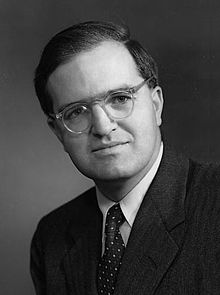Aage Niels Bohr
Aage Niels Bohr (born June 19, 1922 in Copenhagen ; † September 8, 2009 there ) was a Danish physicist and Nobel Prize winner from the University of Copenhagen .
Life
Aage Bohr was the son of Niels Bohr , whom he accompanied as a student in exile to America and England in October 1943 as a secretary and assistant. In 1946 he received his diploma in Copenhagen. In 1948 he was at the Institute for Advanced Study in Princeton and then until 1950 at Columbia University at the invitation of Isidor Isaac Rabi , who investigated the hyperfine structure of deuterium . In this quadrupole moments of the core measured, the very were much higher than the possible Einteilchenwerte and pointed to collective excitations. Experimental advances made it possible to discover rotational bands directly in nuclear spectra around 1953 and to generate transitions between rotational excitations directly by Coulomb excitation, which provided a wealth of new material for the study of collective excitations. 1956–1992 he was a professor at the University of Copenhagen, after the death of his father Niels Bohr he was appointed director of the Niels Bohr Institute (NBI) there from 1963–1970 and director of Nordita , the "Nordic Institute for Theoretical Atomic Physics" , from 1975–1981 , which was founded in 1957 and works closely with the NBI.
In 1975 he received the Nobel Prize in Physics together with Ben R. Mottelson and James Rainwater "for the discovery of the connection between collective and particle motion in atomic nuclei and the development of the theory of the structure of atomic nuclei based on this connection".
With his long-time colleague Ben Mottelson he developed a model of collective excitations in atomic nuclei as a common (often deformed, i.e. no longer spherically symmetrical) potential of the nucleons with their own states of rotation and vibration. They examined u. a. the interaction of collective and single-particle excitations z. B. in heavy lead cores (close to the stable magic numbers of the shell model) and were one of the first to apply the BCS theory of superconductivity in nuclear physics (as did the Russians Arkadi Migdal and Spartak Beljajew ).
In addition to the Nobel Prize, he received the Dannie Heineman Prize in 1960 , the Örsted Medal in 1970 and the Ole Römer Medal in 1976. On May 14, 1969 he was awarded the Atoms for Peace Award along with five other winners . In 1965 he was admitted to the American Academy of Arts and Sciences and the American Philosophical Society , in 1971 to the National Academy of Sciences and in 1981 he was elected a member of the German Academy of Sciences Leopoldina . He was a foreign member of the Polish Academy of Sciences .
He had been married to his wife Marietta since 1950 and had three children with her. Three years after her death in 1978, he married his second wife, Bente.
Fonts
- Bohr, Mottelson: Theory of atomic nuclei , 2 vols., Hanser Verlag 1975, 1979 (strong emphasis on symmetry principles, vol. 1 single-particle movement, first 1969, vol. 2 nuclear deformations, first 1975)
- Bohr, Mottelson: Collective and individual aspects of nuclear structure , Kgl.Dansk Mat.Fys.Medd. Vol. 27, 1953, No. 16, pp. 7-174
- Bohr, Mottelson: The many facets of nuclear structure , Annual Review of Nuclear Science, Vol. 23, 1973, p. 363
- Bohr, Mottelson: Single particle and collective aspects of nuclear rotation , Physica Scripta Vol. 24, 1981, p. 71.
- Bohr, Mottelson, David Pines : Possible analogy between the excitation spectra of nuclei and those of the superconducting metallic state , Physical Review Vol. 110, 1958, p. 936.
literature
- Aage Bohr , in: Internationales Biographisches Archiv 02/2010 from January 12, 2010, in the Munzinger archive ( beginning of article freely available)
Web links
- Literature by and about Aage Niels Bohr in the catalog of the German National Library
- Information from the Nobel Foundation on the 1975 award to Aage Niels Bohr
Individual evidence
- ↑ Member History: Aage Bohr. American Philosophical Society, accessed May 9, 2018 (English, with short biography).
- ↑ Aage Bohr. Member Directory. National Academy of Sciences, accessed March 1, 2018 (American English): "Election Year: 1971"
- ^ Aage Bohr's membership entry at the German Academy of Natural Scientists Leopoldina , accessed on October 12, 2012.
- ↑ Kenneth Chang: Aage Bohr, Physicist's Son Who Won Nobel, Dies at 87. The New York Times, September 10, 2009, accessed March 1, 2018 (American English): “His first wife, Marietta Soffer, whom he married in 1950, died in 1978. They had three children: Vilhelm, Tomas and Margrethe. In 1981, Dr. Bohr married Bente Meyer. "
| personal data | |
|---|---|
| SURNAME | Bohr, Aage Niels |
| BRIEF DESCRIPTION | Danish physicist, winner of the 1975 Nobel Prize in Physics |
| DATE OF BIRTH | June 19, 1922 |
| PLACE OF BIRTH | Copenhagen |
| DATE OF DEATH | September 8, 2009 |
| Place of death | Copenhagen |
